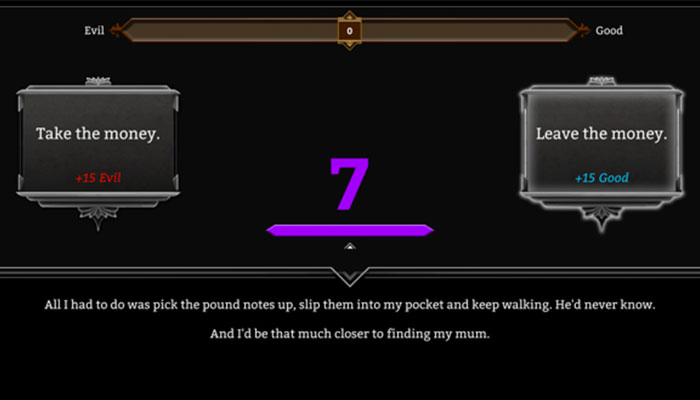Two papers published by a multi-disciplinary research team reveal that most of us ignore the meter when a moral choice is clear, but we use it when the choice is more morally ambiguous. And some of us, about 10 per cent, will do anything to win.

Choices: Ethics snd gaming researchers looked at how morality scores affect player decision-making by building their own game called The Great Fire, pictured above.
The Great Fire, a narrative computer game, was developed by course director of the Games Design and Development Program in the School of Computing Dr Malcom Ryan, and his research partner Professor Paul Formosa, who is co-director of the Macquarie University Ethics and Agency Research Centre and Head of the Department of Philosophy. They were assisted by colleagues cognitive psychologist Dr Stephanie Howarth and writer Dr Jane Messer.
The game story centres on Frankie, an usher in a cinema in regional Australia in the 1940s, who is confronted by a murderous psychopath.
Along the way, players must make choices which affect the progress and outcome of the game. Some are simple black and white decisions, such as whether to take money or not, but others are what developers call 'trolley problems', where players must decide whether they will kill or harm someone if it saves others.
Entertainment and education
Each choice is labelled with a score of good or evil, and your total morality score registers on a meter at the top of the screen throughout the game. But the moral impact of a choice is not always clear. Do you rob a homeless person of money that could assist you? What happens if the moral score insists this is a good thing?
“Our hypothesis was that under that particular circumstance, players might choose to steal,” says Dr Malcolm Ryan.
“But we were relieved to find telling people that stealing money is good doesn’t change their response. Although there will always be about 10 per cent who will choose to do it anyway.
“Morality meters, that indicate how good or evil your avatar is, have been around in computer games since 1985 when Richard Garriott pioneered the idea in Ultima IV."
Games provide a way of simulating different moral scenarios and asking what is the right thing to do.
But until now there has been no empirical data on which to base discussion of their impact on the attractiveness of games, or their effect on players.
“For me, the entertainment value of games is primary. I want to improve them as a designer, not just because they are fun, but because I want to see them become like more mature works of art and literature, able to deal with serious topics of morality.
“Games provide a way of simulating different moral scenarios and asking what is the right thing to do."

Moral choices: New data on how computer game morality scores affect player choices has been published in the journal of Computers in Human Behaviour.
Research findings on The Great Fire have been published in two papers to date, Dr Ryan said.
The first, published in the journal Games and Culture, was qualitative, exploring the feelings of players and their responses to the morality meter. It showed a difference between players who made choices simply to maximise their morality score, and others who viewed the meter as some sort of moral guide.
A second paper published earlier this year in Computers in Human Behaviour provides the first quantitative data on morality meters. The results show the meter is generally ignored when a moral choice is straightforward, but it can influence decisions when the choice is morally ambiguous.
- "Nothing short of miraculous" - The drug offering hope to MND patients
- Will AI mark the exams of the future?
The Department of Computing is currently building a Games User Research Lab where biometric measures, such as skin conductance and eye blink rate can be measured while players are engrossed in computer games.
“Blink rate, for instance, can be an indicator of how deeply you are thinking about something,” Dr Ryan says.
“These biometrics will give us a snapshot of the moment-by-moment experience of players.
“There is a lot of worldwide interest in this area, so I will be running a workshop in person and online at the Digital Games Research Association conference in June being held in Seville, Spain.”
Dr Malcolm Ryan is a senior lecturer in Games Design and Development in the School of Computing, Faculty of Science and Engineering.
Professor Paul Formosa is Head of the Department of Philosophy and co-director of the Macquarie University Ethics and Agency Research Centre in the Faculty of Arts.



